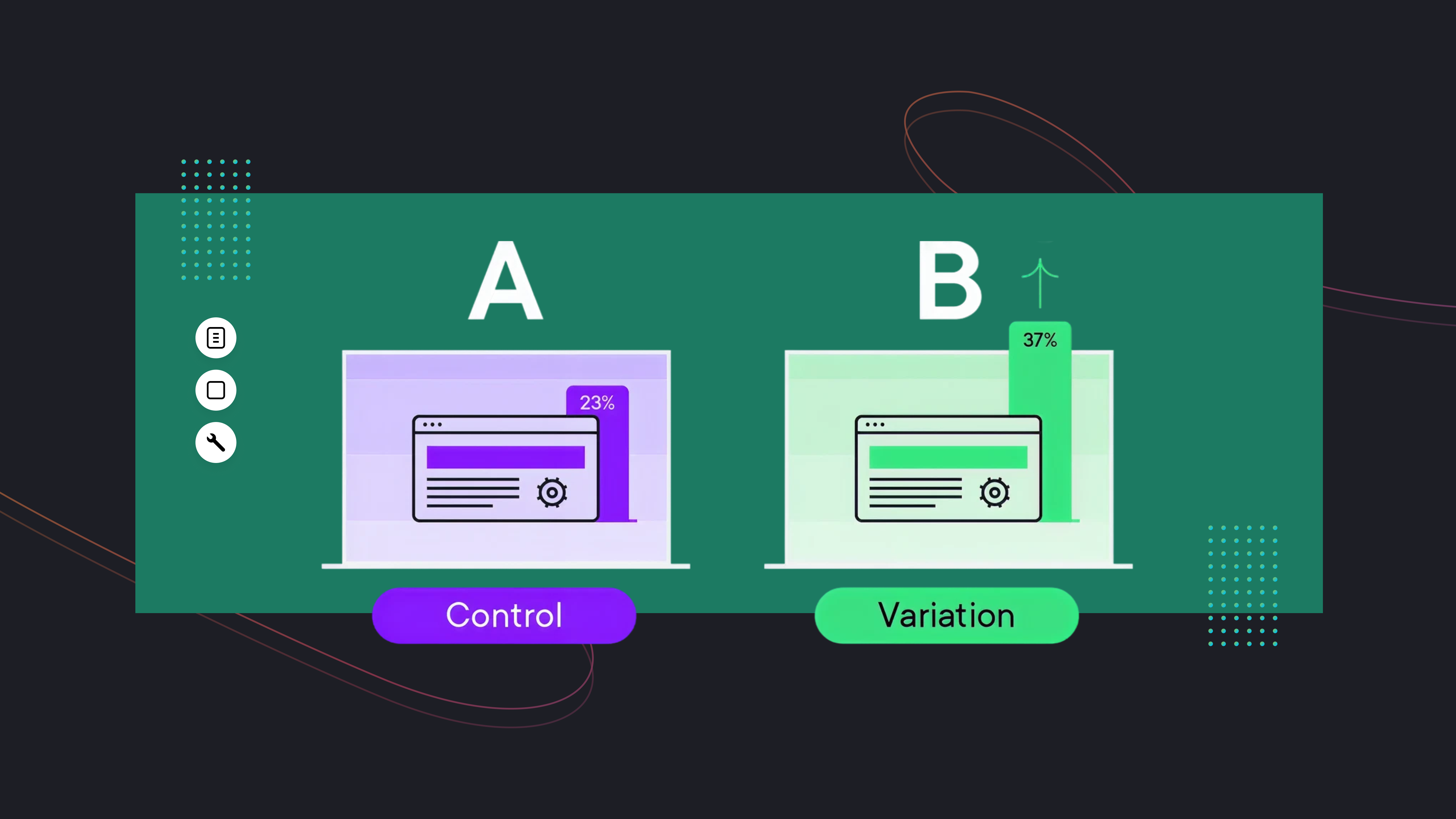- The Core Idea: Aligning Intent with Experience
- Why Homepages May Fail Paid Traffic?
- Hypothesis & Strategy
- Psychological Triggers & Research Insights: Why Relevance Changes Behavior?
- Case Study: TechInsurance’s 73% Lift Through Intent Alignment
- A/B Testing Setup with GemX
- Interpreted Results and What to Look For
- Why GemX Is the Perfect Fit for This Use Case?
This use case explores user intent alignment, cognitive load theory, and how GemX helps validate landing page effectiveness through structured A/B testing.
The Core Idea: Aligning Intent with Experience
Every ad click represents a micro-commitment. When users click, they expect to land somewhere that directly fulfills the promise they just interacted with.
But here’s where most brands lose conversions: They spend hundreds of dollars driving traffic to their homepage — a page designed for broad exploration, not focused action.
A homepage’s job is to tell your story, showcase products, and invite curiosity. But for someone coming from a targeted ad, curiosity isn’t the goal — confirmation is.
That’s where dedicated landing pages outperform. They deliver a single, streamlined journey, confirming the user’s expectation, reinforcing intent, and minimizing distractions.
Let’s unpack why that difference matters so much.
Why Homepages May Fail Paid Traffic?
Imagine you click on an ad for “Get 30% off your first protein order”. You expect to see that offer front and center, but instead, you land on a homepage filled with navigation menus, blog links, and brand videos.
Your brain asks: “Wait, where’s the 30% offer?”, and in that split second of dissonance, you’ve already lost emotional momentum.
This is called the "Motivational Gap": the psychological distance between why a user clicked and what they see first.
Behavioral research explains this gap through four core cognitive mechanisms:
-
Expectation Violation: Users subconsciously predict what they’ll see post-click. When reality doesn’t match, trust drops and exit rates rise.
-
Choice Overload (Hick’s Law): The more paths and links a homepage offers, the longer decision time becomes — often ending in no decision at all.
-
Cognitive Load: Each extra visual, button, or scroll segment consumes attention. When cognitive load rises above intent, users abandon.
-
Goal Gradient Hypothesis: The closer users feel to completing their goal, the faster they act. Landing pages shorten that psychological distance; homepages extend it.
Hypothesis & Strategy
Hypothesis Formation:
|
IF visitors from a PPC campaign are routed to a landing page that mirrors ad intent and removes irrelevant paths,
THEN conversion rate will increase,
BECAUSE relevance reduces context switching, shortens the time-to-decision, and sustains behavioral momentum. |
Strategy
-
Treat the homepage vs landing page comparison as a single-variable A/B test: same creative, same targeting, same budget — only the destination differs.
-
Use GemX to run a controlled experiment that measures downstream conversions and behavioral signals (bounce, time-to-CTA, micro-commitments).
Psychological Triggers & Research Insights: Why Relevance Changes Behavior?
Let’s go deeper into the behavioral principles that make landing pages outperform general homepages for paid campaigns.
1. Expectation Alignment (Predictive Processing)
Humans are prediction engines. Clicking an ad establishes a predictive model. When the landing experience confirms that model, the brain rewards the user with cognitive fluency — decisions feel easier and safer. Disconfirmation triggers micro-dissonance and either reorientation or exit.
2. Information Scent and Foraging Theory
Users follow “information scent”: signals that promise reward. Ads create a scent trail. A landing page that mirrors ad language and imagery maintains that scent; a homepage breaks it. Information foraging theory predicts that users abandon trails with weak scent.
3. Hick’s Law and Cognitive Load
More options = slower decisions.
A homepage introduces branching choices. Landing pages intentionally reduce choice complexity, which accelerates a decision and reduces abandonment risk.
4. Goal-Gradient and Momentum
When the goal appears closer (fewer steps to conversion), motivation increases. Landing pages compress the path and therefore reinforce the goal-gradient effect, converting intent into action faster.
5. Commitment Consistency and Micro-commitments
A click is a micro-commitment. The next screen should amplify that commitment. A landing page aligned with the ad acts as confirmation; a homepage can unintentionally reset the user’s commitment state.
6. Cognitive Fluency and Trust
Easier-to-process pages feel more credible. When page narrative, tone, and visual hierarchy align with the visitor’s expectations, perceived trust rises, which improves conversion probability.
Case Study: TechInsurance’s 73% Lift Through Intent Alignment
How Landing Page Testing Boosted PPC Conversions
TechInsurance faced a common challenge: maximizing the effectiveness of their PPC campaigns.
Background: TechInsurance was running paid search campaigns targeting small business owners looking for liability coverage. All paid clicks were sent to the company’s homepage: a well-designed page, but filled with navigation menus, blog links, and multiple CTAs.
The Problem: Despite steady traffic, the campaign’s conversion rate stagnated. Analytics showed users clicking around, scrolling, and leaving without requesting a quote. The homepage’s breadth was diluting the ad’s transactional intent.
The Hypothesis: A dedicated PPC landing page focused solely on “Get a Free Business Insurance Quote” would outperform the homepage by aligning intent and removing distractions.
The Setup:
They built a streamlined landing page that:
-
Reused the ad headline as the main H1
-
Hide the navigation bar
-
Reduced content to three key benefits
-
Featured a short quote request form above the fold
-
Repeated the CTA at the bottom: “Get My Quote”
Both versions were tested under identical ad spend, targeting, and timing.
The Result:
-
Landing page conversion rate: +73% higher than homepage
-
Bounce rate: –32%
-
Form completion time: –28% faster
The landing page confirmed user expectations instantly.

Case study via Unbounce.
A/B Testing Setup with GemX
GemX enables you to set up this exact experiment without code directly inside Shopify.
It supports testing between different page types (e.g., homepage vs. product page, product page vs. landing page), making it ideal for intent-based experiments.
Below is a full setup guide:
Step 1: Prepare Templates
You need two page templates ready in Shopify (or built with GemPages if you prefer):
-
Version A – Homepage (Control): Standard site homepage with full navigation and brand content.
-
Version B – Landing Page (Variant): A simplified, focused page tailored to your PPC ad offer. Remove menus, limit links, and keep one strong CTA.
Tip: Use consistent branding and headline structure to isolate the variable of “page focus,” not design style.
Step 2: Select Templates in GemX
-
From the GemX Dashboard, click Create new experiment > Create template testing.
-
Under Control Template, select your Homepage (Version A).
-
Under Variant Template, choose your Landing Page (Version B).

Step 3: Configure Advanced Experiment Settings
Once both templates (homepage and landing page) are ready, you define exactly how your traffic will be distributed, tracked, and evaluated.
Each setting directly impacts how reliable and meaningful your test results will be, so it’s crucial to configure them thoughtfully.
1. Winning Metric
Recommended: Conversion
Why choose Conversion Rate: Because the hypothesis is about behavioral efficiency — whether directing ad traffic to a dedicated landing page leads to more people taking the desired action (clicking “Buy Now,” submitting a form, or checking out).
Conversion Rate directly reflects that behavior.

2. Device Targeting
Recommended: All Devices
Why choose All Devices: It provides the most representative data across your entire campaign. Paid ad traffic often spans multiple device types, and performance may differ drastically between them.

3. Visitor Type
Recommended: New Visitors
Why: Your ad traffic is typically cold, first-time users entering your funnel. Testing on new visitors gives you cleaner data on first impressions and message alignment, without bias from prior familiarity with your brand.
If returning visitors are included, they may already know how to navigate your homepage efficiently, masking the true performance difference between homepage vs. landing page.
4. Traffic Source
Recommended: Paid Search or Paid Social
Why: You want to isolate ad-driven visitors. Including organic or referral traffic would dilute the test, since those users arrive with different intent levels. GemX allows you to select specific traffic channels under the Traffic Source filter.
5. Traffic Split
Recommended: 50 / 50
Why: Ensures statistical balance and eliminates sampling bias. GemX’s session persistence guarantees each visitor consistently sees the same version during the experiment, preserving validity.

6. Market & Language
Recommended: Match your ad targeting region (e.g., United States – English).
Why: Cultural cues and linguistic patterns impact conversion decisions. Aligning market and language ensures test integrity and minimizes noise from localization differences.

Step 4: Launch and Monitor
Once setup is complete:
-
Click Start Experiment.

-
GemX begins routing traffic evenly between both pages.
-
Visit Analytics to monitor real-time data.

Interpreted Results and What to Look For
Once your experiment has run long enough to collect meaningful data, open GemX Analytics to review the results. The goal is to understand why it performed better and what to do next.
1. Conversion Rate (Primary Metric)
If your dedicated landing page shows a higher conversion rate than the homepage, it validates your hypothesis: focused intent and fewer distractions improve action rates.
Look for at least 95% confidence before deciding the winner to ensure statistical reliability.
2. Revenue per Visitor
A higher RPV means your landing page not only converts more visitors but also attracts higher-value buyers. If conversion rate rises but RPV falls, your offer might need refinement to sustain purchase value.
3. Segment Analysis
Use GemX filters to view results by device, traffic source.
Why GemX Is the Perfect Fit for This Use Case?
Testing a Homepage vs. Landing Page scenario requires flexibility beyond what typical Shopify A/B tools offer. Here’s why GemX is the most suitable platform for this type of experiment:
1. Cross-Template Testing Capability
GemX allows you to test two completely different templates, even if they belong to different page types (Homepage vs. Product Page, Homepage vs. Landing Page, etc.).
This is crucial for experiments like this — where structure, navigation, and message focus differ entirely.
2. Direct Integration with GemPages
If your pages were built or customized using GemPages, they’re automatically compatible with GemX. No manual tracking code, no custom routing setup — just select the template and start testing.
3. Full Control Over Targeting and Metrics
Unlike many auto-optimization tools, GemX doesn’t make hidden decisions. You choose every parameter — from Traffic Split to Visitor Type to Winning Metric. This transparency ensures that every result is grounded in your experimental intent, not algorithmic bias.
4. Session Consistency and Reliability
GemX ensures that once a visitor is exposed to a variant, they will always return to that same variant during the experiment period. This preserves data integrity and prevents cross-contamination between pages.
5. Shopify-Native Analytics Integration
Because GemX is purpose-built for Shopify, your experiment metrics directly tie back to store data — including orders, RPV, and AOV. That means every test translates to business impact, not just on-page interaction.
6. Iterative Testing Framework
GemX makes continuous experimentation practical. Once your homepage vs. landing page test concludes, you can duplicate the winning variant, modify a single variable (like headline, trust section, or offer framing), and re-launch a new test in minutes.
This turns A/B testing from a one-time experiment into an ongoing growth engine.











